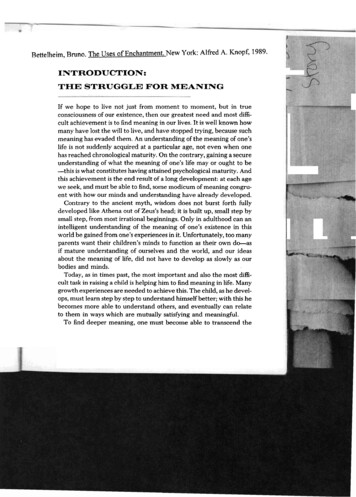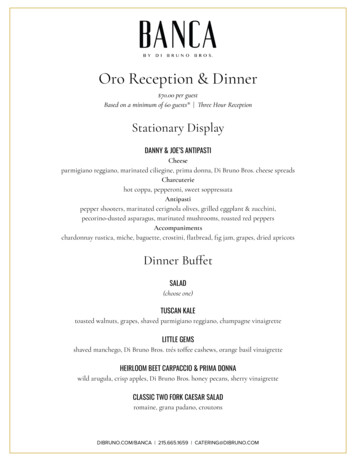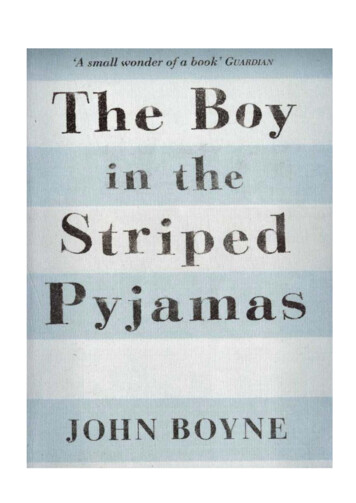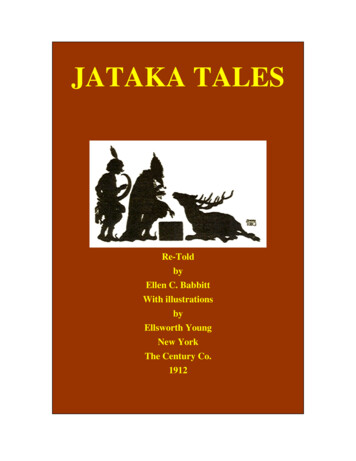
Transcription
Bettelheim, Bruno. The Uses of Enchantment. New York: Alfred A. Knopf, 1989.INTRODUCTION:THE STRUGGLE FOR MEANINGIf we hope to live not just from moment to moment, but in trueconsciousness of our existence, then our greatest need and most difficult achievement is to find meaning in our lives. It is well known howmany have lost the will to live, and have stopped trying, because suchmeaning has evaded them. An understanding of the meaning of one'slife is not suddenly acquired at a particular age, not even when onehas reached chronological maturity. On the contrary, gaining a secureunderstanding of what the meaning of one's life may or ought to be-this is what constitutes having attained psychological maturity. Andthis achievement is the end result of a long development: at each agewe seek, and must be able to find, some modicum of meaning congruent with how our minds and understanding have already developed.Contrary to the ancient myth, wisdom does not burst forth fullydeveloped like Athena out of Zeus's head; it is built up, small step bysmall step, from most irrational beginnings. Only in adulthood can anintelligent understanding of the meaning of one's existence in thisworld be gained from one's experiences in it. Unfortunately, too manyparents want their children's minds to function as their own do-asif mature understanding of ourselves and the world, and our ideasabout the meaning of life, did not have to develop as slowly as ourbodies and minds.Today, as in times past, the most important and also the most difficult task in raising a child is helping him to find meaning in life. Manygrowth experiences are needed to achieve this. The child, as he develops, must learn step by step to understand himself better; with this hebecomes more able to understand others, and eventually can relateto them in ways which are mutually satisfying and meaningful.To find deeper meaning, one must become able to transcend the
INTRODUCTION. --Introduction8professes a belief in an optimistic meliorism. Psychoanalysis itself isviewed as having the purpose of making life easy-but this is not whatits founder intended. Psychoanalysis was created to enable man toaccept the problematic nature of life without being defeated by it, orgiving in to escapism. Freud's prescription is that only by strugglingcourageously against what seem like overwhelming odds can mansucceed in wringing meaning out of his existence.This is exactly the message that fairy tales get across to the child inmanifold form: that a struggle against severe difficulties in life is unavoidable, is an intrinsic part of human existence-but that if one doesnot shy away, but steadfastly meets unexpected and often unjust hardships, one masters all obstacles and at the end emerges victorious.Modern stories written for young children mainly avoid these existential problems, although they are crucial issues for all of us. Thechild needs most particularly to be given suggestions in symbolic formabout how he may deal with these issues and grow safely intomaturity. "Safe" stories mention neither death nor aging, the limitsto our existence, nor the wish for eternal life. The fairy tale, by contrast, confronts the child squarely with the basic human predicaments.For example, many fairy stories begin with the death of a motheror father; in these tales the death of the parent creates the mostagonizing problems, as it (or the 'fear of it) does in real life. Otherstories tell about an aging parent who decides that the time has cometo let the new generation take over. But before this can happen, thesuccessor has to prove himself capable and worthy. The BrothersGrimm's story "The Three Feathers" begins: "There was once upona time a king who had three sons. . . . When the king had become oldand weak, and was thinking of his end, he did not know which of hissons should inherit the kingdom after him." In order to decide, theking sets all his sons a difficult task; the son who meets it best "shallbe king after my death."It is characteristic of fairy tales to state an existential dilemmabriefly and pointedly. This permits the child to come to grips with theproblem in its most essential form, where a more complex plot wouldconfuse matters for him. The fairy tale simplifies all situations. Itsfigures are clearly drawn; and details, unless very important, areeliminated. All characters are typical rather than unique.Contrary to what takes place in many modern children's stories, infairy tales evil is as omnipresent as virtue. In practically every fairytale good and evil are given body in the form of some figures and theirIIIIIIIIiIactions, as good and e\for both are present i moral problem, and rcEvil is not without ilor dragon, the powelWhitew-and often it itales a usurper succeefully belongs to the heis not that the evildocimmersing oneself in 1although this is part ofof it is only a limited (does not pay is a muclfairy tales the bad perswins out at the end whattractive to the child,Because of this identilthe hero his trials andis victorious. The chilcthe inner and outer siThe figures in fairythe same time, as wenates the child's mindgood or bad, nothingclever. One sister is vlazy. One is beautiful,other evil. The juxtaptpose of stressing right(There are some amoror ugliness play no ropermits the child to two, which he could Itrue to life, with all tAmbiguities must waestablished on the ba:a basis for understanpeople, and that the1wants to be. This basiopment will build, isFurthermore, a chversus wrong, as on u
1iIntroductionII11I9actions, as good and evil are omnipresent in life and the propensitiesfor both are present in every man. It is this duality which poses thenloral problem, and requires the struggle to solve it.Evil is not without its attractions-symbolized by the mighty gianlr dragon, the power of the witch, the cunning queen in "Snow,Jhite"-and often it is temporarily in the ascendancy. In many fairytales a usurper succeeds for a time in seizing the place which rightfully belongs to the hero-as the wicked sisters do in "Cinderella." Itis not that the evildoer is punished at the story's end which makesnmersing oneself in fairy stories an experience in moral education,lthough this is part of it. In fairy tales, as in life, punishment or fearof it is only a limited deterrent to crime. The conviction that crirrdoes not pay is a much more effective deterrent, and that is whyfairy tales the bad person always loses out. It is not the fact that virt wins out at the end which promotes morality, but that the hero is mosrattractive to the child, who identifies with the hero in all his struggles.Because of this identification the child imagines that he suffers withthe hero his trials and tribulations, and triumphs with him as virtueis victorious. The child makes such identifications all on his own, andthe inner and outer struggles of the hero imprint morality on him.The figures in fairy tales are not ambivalent-not good and bad atthe same time, as we all are in reality. But since polarization dominates the child's mind, it also dominates fairy tales. A person is eithergood or bad, nothing in between. One brother is stupid, the other isclever. One sister is virtuous and industrious, the others are vile andlazy. One is beautiful, the others are ugly. One parent is all good, theother evil. The juxtaposition of opposite characters is not for the purpose of stressing right behavior, as would be true for cautionary tales.(There are some amoral fairy tales where goodness or badness, beautyor ugliness play no role at all.) Presenting the polarities of charactpermits the child to comprehend easily the difference between tltwo, which he could not do as readily were the figures drawn motrue to life, with all the complexities that characterize real people.Ambiguities must wait until a relatively firm personality has beenestablished on the basis of positive identifications. Then the child hasa basis for understanding that there are great differences betweenpeople, and that therefore one has to make choices about who onewants to be. This basic decision, on which all later personality development will build, is facilitated by the polarizations of the fairy tale.Furthermore, a child's choices are based, not so much on rightversus wrong, as on who arouses his sympathy and who his antipathy.
INTRODUCTION10The more simple and straightforward a good character, the easier itis for a child to identify with it and to reject the bad other. The childidentifies with the good hero not because of his goodness, but becausethe hero's condition makes a deep positive appeal to him. The question for the child is not "Do I want to be good?" but "Who do I wantto be like?" The child decides this on the basis of projecting himselfwholeheartedly into one character. If this fairy-tale figure is a verygood person, then the child decides that he wants to be good, too.Amoral fairy tales show no polarization or juxtaposition of good andbad persons; that is because these amoral stories serve an entirelydifferent purpose. Such tales or type figures as "Puss in Boots," whoarranges for the hero's success through trickery, and Jack, who stealsthe giant's treasure, build character not by promoting choices between good and bad, but by giving the child the hope that even themeekest can succeed in life. After all, what's the use of choosing tobecome a good person when one feels so insignificant that he fears hewill never amount to anything? Morality is not the issue in these tales,but rather, assurance that one can succeed. Whether one meets lifewith a belief in the possibility of mastering its difficulties or with theexpectation of defeat is also a very important existential problem.The deep inner conflicts originating in our primitive drives and ourviolent emotions are all denied in much of modern children's literature, and so the child is not helped in coping with them. But the childis subject to desperate feelings of loneliness and isolation, and he oftenexperiences mortal anxiety. More often than not, he is unable toexpress these feelings in words, or he can do so only by indirection:fear of the dark, of some animal, anxiety about his body. Since itcreates discomfort in a parent to recognize these emotions in his child,the parent tends to overlook them, or he belittles these spoken fearsout of his own anxiety, believing this will cover over the child's fears.The fairy tale, by contrast, takes these existential anxieties anddilemmas very seriously and addresses itself directly to them: theneed to be loved and the fear that one is thought worthless; the loveof life, and the fear of death. Further, the fairy tale offers solutions inways that the child can grasp on his level of understanding. For example, fairy tales pose the dilemma of wishing to live eternally by occasionally concluding: "If they have not died, they are still alive." Theother ending-"And they lived happily ever after"--does not for amoment fool the child that eternal life is possible. But it does indicatethat which alone can take the sting out of the narrow limits of our timeon this earth: forming a truly satisfying bond to another. The talesteach that when one has done this, one has reached the ultimate inIntroductionemotional security of e?to man; and this alone ctrue adult love, the faireternal life. This is sugt"They lived for a longAn uninformed viewunrealistic wish-fulfillmsage it conveys to the ctinterpersonal relation,haunts him (and which !resolved at the story's E:ing is not made possiblcon to his mother eternadeath anxiety by despcwill only be cruelly forOnly by going out in1himself there; and as hhe will be able to live Ihaving to experience sented and guides the cconscious and his unccpendency wishes andtence.Today children no 1tended family, or of amore than at the timeprovide the modern ctinto the world all by throf the ultimate things,their right way with dThe fairy-tale hero Fchild often feels isolateprimitive things-a trcin touch with those tlheroes convinces the (abandoned in the worcourse of his life he wilit is needed. Today, evlreassurance offered byless is capable of achiethe world around him
Introduction11emotional security of existence and permanence of relation availableto man; and this alone can dissipate the fear of death. If one has foundtrue adult love, the fairy story also tells, one doesn't need to wish foreternal life. This is suggested by another ending found in fairy tales:"They lived for a long time afterward, happy and in pleasure."An uninformed view of the fairy tale sees in this type of ending anunrealistic wish-fulfillment, missing completely the important message it conveys to the child. These tales tell him that by forming a trueinterpersonal relation, one escapes the separation anxiety whichhaunts him (and which sets the stage for many fairy tales, but is alwaysresolved at the story's ending). Furthermore, the story tells, this ending is not made possible, as the child wishes and believes, by holdingon to his mother eternally. If we try to escape separation anxiety anddeath anxiety by desperately keeping our grasp on our parents, wewill only be cruelly forced out, like Hansel and Gretel.Only by going out into the world can the fairy-tale hero (child) findhimself there; and as he does, he will also find the other with whomhe will be able to live happily ever after; that is, without ever againhaving to experience separation anxiety. The fairy tale is future-oriented and guides the child-in terms he can understand in both hisconscious and his unconscious mind-to relinquish his infantile dependency wishes and achieve a more satisfying independent existence.Today children no longer grow up within the security of an extended family, or of a well-integrated community. Therefore, evenmore than at the times fairy tales were invented, it is important toprovide the modern child with images of heroes who have to go outinto the world all by themselves and who, although originally ignorantof the ultimate things, find secure places in the world by followingtheir right way with deep inner confidence.The fairy-tale hero proceeds for a time in isolation, as the modernchild often feels isolated. The hero is helped by being in touch withprimitive things-a tree, an animal, nature-as the child feels morein touch with those things than most adults do. The fate of theseheroes convinces the child that, like them, he may feel outcast andabandoned in the world, groping in the dark, but, like them, in thecourse of his life he will be guided step by step, and given help whenit is needed. Today, even more than in past times, the child needs thereassurance offered by the image of the isolated man who nevertheless is capable of achieving meaningful and rewarding relations withthe world around him.-'II1IiI---.- -.I' fPIIiI1-"
INTRODUCTION12The Fairy Tale: A Unique Art FormWhile it entertains the child, the fairy tale enlightens him about himself, and fosters his personality development. It offers meaning on somany different levels, and enriches the child's existence in so manyways, that no one book can do justice to the multitude and diversityof the contributions such tales make to the child's life.This book attempts to show how fairy stories represent in imaginative form what the process of healthy human development consists of,and how the tales make such development attractive for the child toengage in. This growth process begins with the resistance against theparents and fear of growing up, and ends when youth has truly founditself, achieved psychological independence and moral maturity, andno longer views the other sex as threatening or demonic, but is ableto relate positively to it. In short, this book explicates why fairy talesmake such great and positive psychological contributions to thechild's inner growth.The delight we experience when we allow ourselves to respond toa fairy tale, the enchantment we feel, comes not from the psychological meaning of a tale (although this contributes to it) but from itsliterary qualities-the tale itself as a work of art. The fairy tale couldnot have its psychological impact on the child were it not first andForemost a work of art.Fairy tales are unique, not only as a form of literature, but as worksof art which are fully comprehensible to the child, as no other formof art is. As with all great art, the fairy tale's deepest meaning will bedifferent for each person, and different for the same person at variousmoments in his life. The child will extract different meaning from thesame fairy tale, depending on his interests and needs of the moment.When given the chance, he will return to the same tale when he isready to enlarge on old meanings, or replace them with new ones.As works of art, fairy tales have many aspects worth exploring inaddition to the psychological meaning and impact to which this bookis devoted. For example, our cultural heritage finds expression in fairytales, and through them is communicated to the child's mind.* An*One example may illustrate: In the Brothers Grimm's story "The Seven Ravens,"seven brothers disappear and become ravens as their sister enters life. Water has tobe fetched from the well in a jug for the girl's baptism, and the loss of the jug is thefateful event which sets the stage for the story. The ceremony of baptism also heraldsIIntroductionother volume could detaido make to the child's mcon in the pages which fcFolklorists approach falinguists and literary critiIt is interesting to observLittle Red Riding Hood'!night devouring the da)replacing the warm seasftim, and so on. Interestiioffer little to the parent oa fairy story may have tofar removed from interplwith nature or celestialFairy tales also abouncof the same nature as fasociations which fairy t aon his general frame ofHence, religious person:is not mentioned here.Most fairy tales origi important part of life; tlreligious themes. The stcof references to Islamichave religious content; 1and unknown to the largious themes no longer .associations. The neglebeautiful stories of the Ithe beginning of a Christianrepresenting that which hadthey represent the pre-Christhe sky gods of antiquity. Tsucceed only if the old creedity, the brothers who repreravens, they dwell in a moccontinued existence in a subtoccurs only because the sistcChristian idea that only thoseprevents them from reachi allowed to enter heaven. Thcremained at first arrested in8
6Introduction'3!other volume could detail the unique contribution fairy tales can anddo make to the child's moral education, a topic which is only touchedon in the pages which follow.Folklorists approach fairy tales in ways germane to their discipline;linguists and literary critics examine their meaning for other reasons.It is interesting to observe that, for example, some see in the motif ofLittle Red Riding Hood's being swallowed by the wolf the theme ofnight devouring the day, of the moon eclipsing the sun, of winterreplacing the warm seasons, of the god swallowing the sacrificial victim, and so on. Interesting as such interpretations are, they seem tooffer little to the parent or educator who wants to know what meaninga fairy story may have to the child, whose experience is, after all, quitefar removed from interpretations of the world onI the basis of concernswith nature or celestial deities.Fairy tales also abound in religious mc)tifs; ma1iy Biblical stories areof the same nature as fairy tales. The conscious and unconscious associations which fairy tales evoke in the mind of the listener dependon his general frame of reference and his personal preoccupations.Hence, religious persons will find in them much of importance thatis not mentioned here.Most fairy tales originated in periods when religion was a mostimportant part of life; thus, they deal, directly or by inference, withreligious themes. The stories of The Thousand and One Nights are fullof references to Islamic religion. A great many Western fairy taleshave religious content; but most of these stories are neglected todayand unknown to the larger public just because, for many, these religious themes no longer arouse universally and personally meaningfulassociations. The neglect of '7ly's Child," one of the Imostbeautiful stories of the Brother!I, illustrates this. It begin s ex-I-IiI11IijIf1,IiI.IiI'I,."the beginning of a Christian existenct. La rvasible to view the seven brothel. lurepresenting that which had to disappear for Christianity to come into being. If so,they represent the pre-Christian, pagan world in which the seven planets stood forthe sky gods of antiquity. The newborn girl is then the new religion, which cansucceed only if the old creed does not interfere with its development. With Christianity, the brothers who represent paganism become relegated to darkness. But asravens, they dwell in a mountain at the end of the world, and this suggests theircontinued existence in a subterranean, subconscious world. Their return to humanityoccurs only because the sister sacrifices one of her fingers, and this conforms to theChristian idea that only those who are willing to sacrifice that part of their body whichprevents them from reaching perfection, if the circumstance requires it, will beallowed to enter heaven. The new religion, Christianity, can liberate even those whoremained at first arrested in paganism.e-"II,QlXS *KAfidlLC:g;'IiI &. !?'.*
Introductionactly like "Hansel and Gretel": "Hard by a great forest dwelt a woodcutter with his wife." AS in "Hansel and Gretel," the couple are sop'oor that they can no longer feed themselves and their three-year-olddaughter. Moved by their distress, the Virgin Mary appears to themand offers to take care of the little girl, whom she takes with her toheaven. The girl lives a wonderful life there until she reaches the ageof fourteen. At this time, much as in the very different tale of "Bluebeard," the Virgin entrusts the girl with the keys to thirteen doors,twelve of which she may open, but not the thirteenth. The girl cannotresist this temptation; she lies about it, and in consequence has toreturn to earth, mute. She undergoes severe ordeals and is about tobe burned at the stake. At this moment, as she desires only to confessher misdeed, she regains her voice to do so, and is granted by theVirgin "happiness for her whole life." The lesson of the story is: a voiceused to tell lies leads us only to perdition; better we should be deprived of it, as is the heroine of the story. But a voice used to repent,to admit our failures and state the truth, redeems us.Quite a few of the Brothers Grimm's other stories contain or beginwith religious allusions. "The Old Man Made Young Again" starts: "Atthe time when our Lord still walked the earth, he and St. Peterstopped one evening at a smith's house. . . ." In another story, "ThePoor Man and the Rich Man," God, like any other fairy-tale hero, istired from walking. That story begins: "In olden times, when the Lordhimself still used to walk about on this earth amongst men, it oncehappened that he was tired and overtaken by the darkness before he .could reach an inn. Now there stood on the road before him twohouses facing each other. . . ." But important and fascinating as thesereligious aspects of fairy stories are, they remain beyond the scope andpurpose of this book, and so are left unexamined here.Even given this book's relatively restricted purpose, that of suggesting why fairy tales are so meaningful to children in helping them copewith the psychological problems of growing up and integrating theirpersonalities, some serious but necessary limitations have had to beaccepted.The first of these lies in the fact that today only a small number offairy tales are widely known. Most of the points made in this bookcould have been illustrated more vividly if some of the more obscurefairy stories could have been referred to. But since these tales, thoughonce familiar, are presently unknown, it would have been necessaryto reprint them here, making for a book of unwieldy size. Thereforethe decision was made to concentrate on a few still-popular fairystories, to show some of their underlying meanings, and how theseII1IImay relate to the child's gof ourselves and of the WOIthan striving for an exhaiexamines some well-knowand pleasure that may beIf this book had been deibeen possible to show marcomplete probing of theirthis, each story has meaniimportant to a particular chis psychological stage ofmost pressing to him at tseemed reasonable to conthis has the shortcoming cmuch more significant tohe is struggling with at tlimitation of this presentaFor example, in discussito hold on to his parents ethe world on his own is sprimitive orality, symboligingerbread house. Thus,to offer to the young chillworld. It gives body to hisfears because even in thebeing devoured-they prous in the end, and a mosdefeated. Thus, a good cgreatest appeal and valubegin to exercise their bfour or five.But separation anxietyfear, including oral greecriod of development. Sucand thus this tale also hasto, much older children.find it considerably morbeing deserted by his par,more reason to let the fato his unconscious anxietiing to conscious awarencOther features of the :
Introductionmay relate to the child's growing-up problems, to our understandingof ourselves and of the world. And the second part of the book, ratherthan striving for an exhaustive completeness that is beyond reach,examines some well-known favorites in some dc.tail, for the meaningand pleasure that may be gained from them.If this book had been devoted to only one or two tales, it would havebeen possible to show many more of their facets, although even thencomplete probing of their depths would not have been achieved; forthis, each story has meanings on too many levels. Which story is mostimportant to a particular child at a particular age depends entirely onhis psychological stage of development, and the problems which aremost pressing to him at the moment. While in writing the book itseemed reasonable to concentrate on a fairy tale's central meanings,this has the shortcoming of neglecting other aspects which might bemuch more significant to some individual child because of problemshe is struggling with at the time. This, then, is another necessarylimitation of this presentation.For example, in discussing "Hansel and Gretel," the child's strivingto hold on to his parents even though the time has come for meetingthe world on his own is stressed, as well as the need to transcend aprimitive orality, symbolized by the children's infatuation with thegingerbread house. Thus, it would seem that this fairy tale has mostto offer to the young child ready to make his first steps out into theworld. It gives body to his anxieties, and offers reassurance about thesefears because even in their most exaggerated. form-anxieties aboutbeing devoured-they prove unwarranted: the children are victorious in the end, and a most threatening enemy-the witch-is utterlydefeated. Thus, a good case could be made that this story has itsgreatest appeal and value for the child at the age when fairy talesbegin to exercise their beneficial impact, that is, around the age offour or five.But separation anxiety-the fear of being deserted-and starvationfear, including oral greediness, are not restricted to a particular period of development. Such fears occur at all ages in the unconscious,and thus this tale also has meaning for, and provides encouragementto, much older children. As a matter of fact, the older person mightfind it considerably more difficult to admit consciously his fear ofbeing deserted by his parents, or to face his oral greed; and this is evenmore reason to let the fairy tale speak to his unconscious, give bodyto his unconscious anxieties, and relieve them, without this ever coming to conscious awareness.Other features of the same story may offer much-needed reassur-II1iIt6qr5rni1-- ?1,.,yI '1i'I -1--
INTRODUCTION16ance and guidance to an older child. In early adolescence a girl hadbeen fascinated by "Hansel and Gretel," and had derived great comfort from reading and rereading it, fantasizing about it. As a child, shehad been dominated by a slightly older brother. He had, in a way,shown her the path, as Hansel did when he put down the pebbleswhich guided his sister and himself back home. As an adolescent, thisgirl continued to rely on her brother; and this feature of the story feltreassuring. But at the same time she also resented the brother's dominance. Without her being conscious of it at the time, her struggle forindependence rotated around the figure of Hansel. The story told herunconscious that to follow Hansel's lead led her back, not forward, andit was also meaningful that although Hansel was the leader at thestory's beginning, it was Gretel who in the end achieved freedom andindependence for both, because it was she who defeated the witch.As an adult, this woman came to understand that the fairy tale hadhelped her greatly in throwing off her dependence on her brother, asit had convinced her that an early dependence on him need notinterfere with her later ascendancy. Thus, a story which for one reason had been meaningful to her as a young child provided guidancefor her at adolescence for a quite different reason.The central motif of "Snow White" is the pubertal girl's surpassingin every way the evil stepmother who, out of jealousy, denies her anindependent existence-symbolically represented by the stepmother's trying to see Snow White destroyed. The story's deepest meaningfor one particular five-year-old, however, was far removed from thesepubertal problems. Her mother was cold and distant, so much so thatshe felt lost. The story assured her that she need not despair: SnowWhite, betrayed by her stepmother, was saved by males-first thedwarfs and later the prince. This child, too, did not despair becauseof
is victorious. The child makes such identifications all on his own, and the inner and outer struggles of the hero imprint morality on him. 1 The figures in fairy tales are not ambivalent-not good and bad at the same time, as we all are in reality. But since polarization domi- nates the child's mind, it also dominates fairy tales. A person is either










